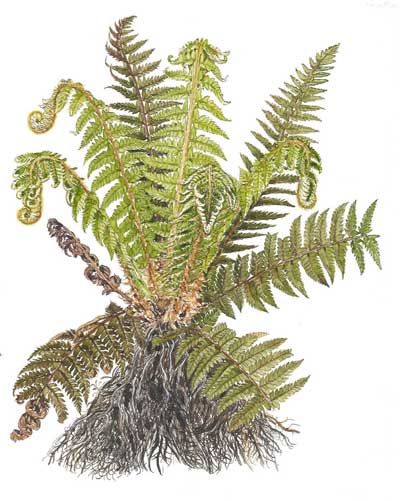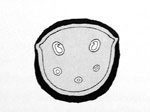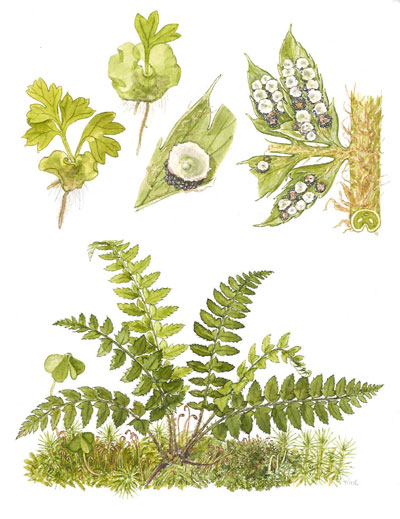| Polystichum aculeatum | ||
Hard shield fern | ||
|
Etymology
Aculeatum means prickly.
Description
Rhizome: erect, branching, stout.
Frond: 60 cm high by 14 cm wide, evergreen, remaining green through the following summer, monomorphic, blade/stipe ratio: 5:1. Stipe: grooved, mixed large and small reddish-brown scales, smaller and narrower upwards to hair-like at the top of the rachis, vascular bundles: 4 or more, in an arc. Blade: 2-pinnate, juveniles less, more divided closer to the rachis and closer to the base, lanceolate, glossy, leathery, dark green, linear to lanceolate scales on rachis and costa, lamina glabrous above, a few sparse hairs or scales below. Pinnae: 25 to 40 pair, subopposite, lowest pinnae half the length of the middle ones, pinnae generally curving upward; pinnules adnate to the pinnae, the first pinnule on the upper side generally larger than the others; all pinnules have an outward-pointing spiny-tipped lobe at the base, curved towards the pinna apex; costae grooved above, not continuous with rachis; margins very spiny; veins free, forked, anadromic. Sori: round, in 1 row on each side of the costa between midrib and margin on the upper half of the blade, indusium: peltate, shriveling upwards like an inverted umbrella, but persistent, central, sporangia: dark brown or black, maturity: midsummer to mid-winter. Culture
Habitat: uplands, rocky outcrops, on limestone.
Distribution: Europe, northern Africa and perhaps eastward to the Himalayas, Japan, Taiwan.
Hardy to -30�C, USDA Zone 4.
Distinctive Characteristics
Similar in many respects to P. braunii, but the pinnae at the base are half the length of the middle (not tiny). This is also a smaller plant with fewer fronds, a glossier lamina.
Synonyms
Polypodium aculeatum L. Polystichum lobatum (Huds.) C. Presl Aetopteron aculeatum House Aspidium aculeatum (L.) Swartz Aspidium aculeatum ssp. lobatum (Hudson) Niessl Aspidium munitum Sadl. Dryopteris aculeata O. Ktze. Dryopteris setifera ssp. lobata (Hudson) Maire Hypopeltis aculeata Tod. Tectaria aculeata Lag., Garcia & Clem. |
|
|
Notes
Parents P. setiferum and P. lonchitis are its parents. Confusion with the latter is unlikely because P. lonchitis is 1-pinnate. Confusion with P. setiferum is possible, but note the fronds here are less numerous in the tuft, are more upright, the stipes shorter, and the basal pinnae shorter than the middle ones, all untrue with P. setiferum.
Parents P. setiferum and P. lonchitis are its parents. Confusion with the latter is unlikely because P. lonchitis is 1-pinnate. Confusion with P. setiferum is possible, but note the fronds here are less numerous in the tuft, are more upright, the stipes shorter, and the basal pinnae shorter than the middle ones, all untrue with P. setiferum.

Polystichum aculeatum. Habit; note tasseling of unfurling fronds, a development characteristic of Polystichum. Also, last year's frond still in evidence, and not decumbent. �Illustration from Scandinavian Ferns by Benjamin �llgaard and Kirsten Tind, Rhodos, 1993. |

Polystichum aculeatum. Frond. �Illustration from Scandinavian Ferns by Benjamin �llgaard and Kirsten Tind, Rhodos, 1993. |

Polystichum aculeatum. Stipe base with five vascular bundles. �Illustration from Scandinavian Ferns by Benjamin �llgaard and Kirsten Tind, Rhodos, 1993. |
